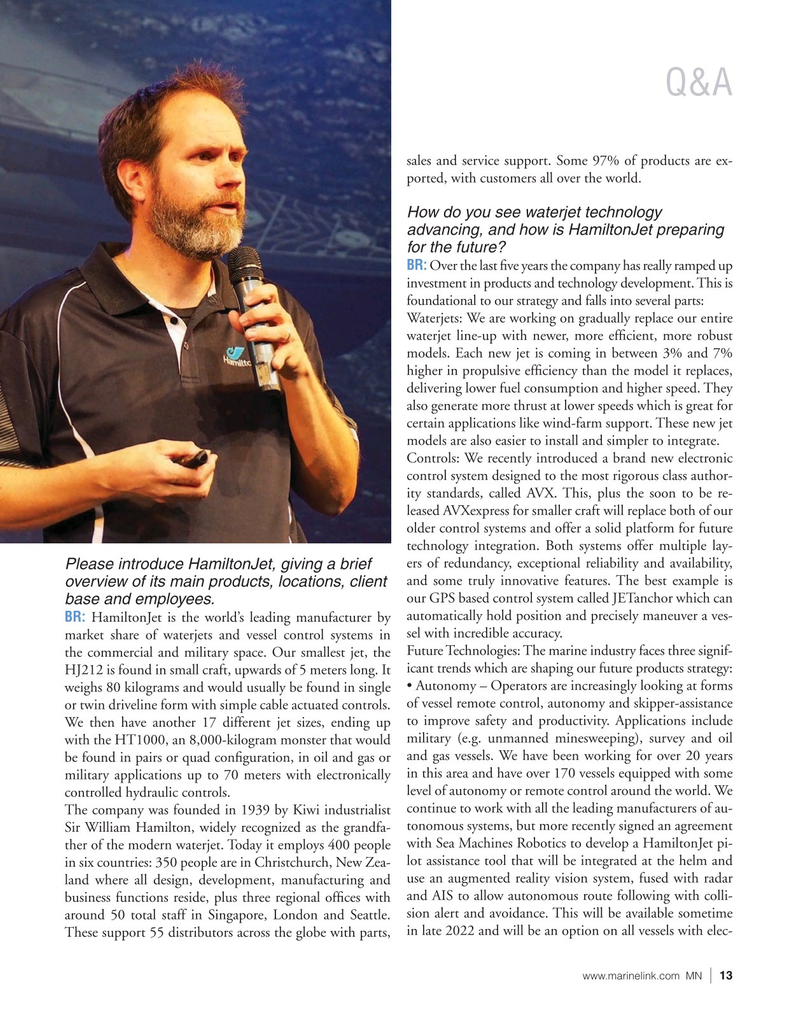
Page 13: of Marine News Magazine (July 2021)
Propulsion Technology
Read this page in Pdf, Flash or Html5 edition of July 2021 Marine News Magazine
Q&A sales and service support. Some 97% of products are ex- ported, with customers all over the world.
How do you see waterjet technology advancing, and how is HamiltonJet preparing for the future?
BR: Over the last ? ve years the company has really ramped up investment in products and technology development. This is foundational to our strategy and falls into several parts:
Waterjets: We are working on gradually replace our entire waterjet line-up with newer, more ef? cient, more robust models. Each new jet is coming in between 3% and 7% higher in propulsive ef? ciency than the model it replaces, delivering lower fuel consumption and higher speed. They also generate more thrust at lower speeds which is great for certain applications like wind-farm support. These new jet models are also easier to install and simpler to integrate.
Controls: We recently introduced a brand new electronic control system designed to the most rigorous class author- ity standards, called AVX. This, plus the soon to be re- leased AVXexpress for smaller craft will replace both of our older control systems and offer a solid platform for future technology integration. Both systems offer multiple lay- ers of redundancy, exceptional reliability and availability,
Please introduce HamiltonJet, giving a brief and some truly innovative features. The best example is overview of its main products, locations, client our GPS based control system called JETanchor which can base and employees.
BR: HamiltonJet is the world’s leading manufacturer by automatically hold position and precisely maneuver a ves- market share of waterjets and vessel control systems in sel with incredible accuracy.
the commercial and military space. Our smallest jet, the Future Technologies: The marine industry faces three signif-
HJ212 is found in small craft, upwards of 5 meters long. It icant trends which are shaping our future products strategy: weighs 80 kilograms and would usually be found in single • Autonomy – Operators are increasingly looking at forms or twin driveline form with simple cable actuated controls. of vessel remote control, autonomy and skipper-assistance
We then have another 17 different jet sizes, ending up to improve safety and productivity. Applications include with the HT1000, an 8,000-kilogram monster that would military (e.g. unmanned minesweeping), survey and oil be found in pairs or quad con? guration, in oil and gas or and gas vessels. We have been working for over 20 years military applications up to 70 meters with electronically in this area and have over 170 vessels equipped with some level of autonomy or remote control around the world. We controlled hydraulic controls.
The company was founded in 1939 by Kiwi industrialist continue to work with all the leading manufacturers of au- tonomous systems, but more recently signed an agreement
Sir William Hamilton, widely recognized as the grandfa- ther of the modern waterjet. Today it employs 400 people with Sea Machines Robotics to develop a HamiltonJet pi- lot assistance tool that will be integrated at the helm and in six countries: 350 people are in Christchurch, New Zea- land where all design, development, manufacturing and use an augmented reality vision system, fused with radar business functions reside, plus three regional of? ces with and AIS to allow autonomous route following with colli- around 50 total staff in Singapore, London and Seattle. sion alert and avoidance. This will be available sometime
These support 55 distributors across the globe with parts, in late 2022 and will be an option on all vessels with elec- www.marinelink.com MN 13|

 12
12

 14
14
